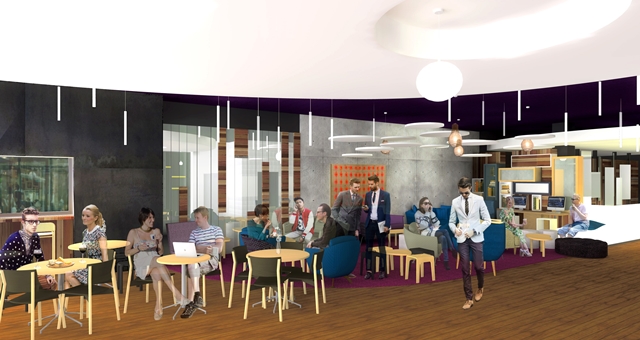
Leading New Zealand hotel architect RICHARD DALMAN looks at the ongoing evolution of the hotel lobby.
The emergence of a new hotel culture, where connectivity in its broadest sense is pre-eminent, has revolutionised the hotel lobby of today.
Guests are being lured out of their rooms into cleverly blended lobbies that become a social and business hub; where they can connect with colleagues and friends as well as their “devices”. This new lobby environment provides lively social areas, relaxed spaces for coffee meetings and more intimate spots for undertaking individual work while still making the guest feel part of the vibrancy of the hotel.
Gone are the days of the separated lobby, bar, restaurant and lounge area. The trend now is for these spaces merge into one with a range of seating types and styles – the guest chooses where and on what to sit on.
People feel like friends in the community styled environment that appeals to both in-house guests and locals who can enjoy food and beverage offerings throughout the entire day and evening benefiting hotel revenues. Free fast Wi-Fi is essential to make the modern lobby hum. Important features to attract locals into the lobby are visible, physical and emotional “connections” that provide a point of difference and invite customers to enjoy an “other” world.
Hotel lobbies still need to perform the tasks of old – welcoming guests, introducing the essence of the hotel, checking guests in and out, providing hotel and destination information, way-finding and suitable waiting areas.
The lobby is usually the first opportunity to personally welcome guests to a hotel, to make them feel relaxed and comfortable. The feel and form of the lobby – along with the staff of course – go a long way to successfully create an inviting welcome.
New forms of e-check in via mobile phones or kiosks for example are becoming more common but have not yet overtaken the personal check in and even where such kiosks exist, hotels still tend to provide a ‘host’ to assist. For traditional check ins, individual “pods” provide a more personal experience where the receptionist can easily move to be beside the guest rather than blocked behind a long reception counter.
In creating successful lobbies, a designer needs to understand the essence of the hotel – Where is it located – city, countryside, beach? What part of the world? Who is the target clientele and what do they need, expect and desire? The lobby needs to pay homage to these elements and be consistent with the essence of the hotel. A hotel’s design being very authentic to its location is a growing trend.
An example is Te Waonui Forest Retreat in Franz Josef, New Zealand which is set amongst native bush, the lobby features predominantly timber surfaces reflecting the natural environment, and the seated reception experience is consistent with the relaxed retreat feel of the hotel.
Amongst today’s blended lobby environment it is still essential to get the basics right, to have a logic to the layout making it clear to guests where key aspects such as reception and lifts are.
The investment to develop or revitalise lobbies into a seamless, multifunctional space with accessible technology can be a commercially astute one that potentially reduces the physical space required and therefore capital costs. It also enhances revenue streams – not only from food and beverage spend but from room revenues resulting from the desire of modern travellers to stay in a vibrant hotel where they feel comfortable to socialise, work or just “hang out”.
The blended lobby can provide a more holistic experience for the guest, making their stay more convenient, enjoyable and memorable – all the elements to encourage a return visit.
Richard Dalman is the Managing Director of Dalman Architecture

